Effective Strategies to Deter Bumblebees Naturally
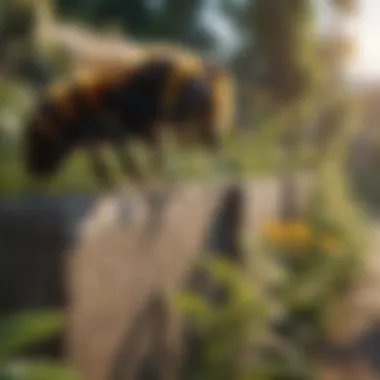
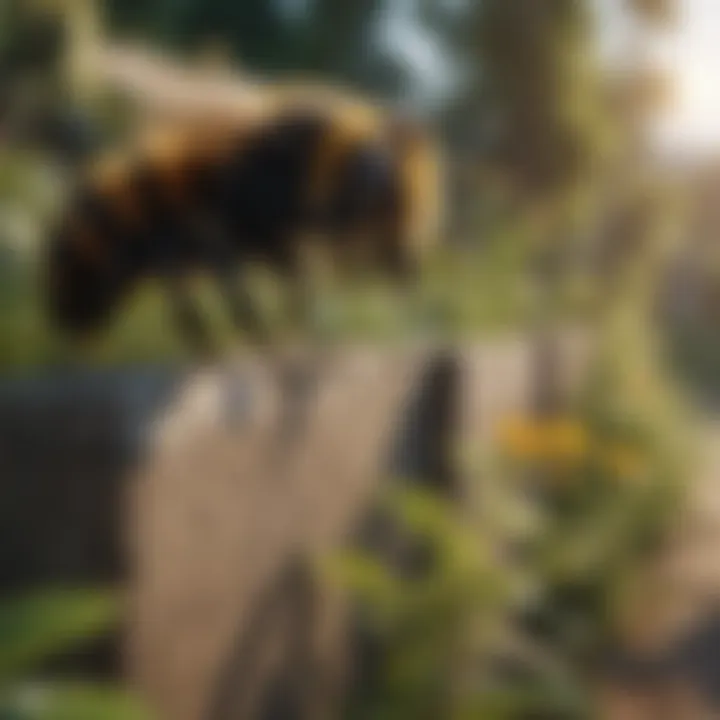
Intro
Bumblebees are vital for the ecosystem, known for their role as pollinators. However, when they invade residential areas, they can become a nuisance. Understanding how to effectively manage their presence is essential for maintaining comfort in homes while also respecting their ecological importance. This article aims to provide a comprehensive overview of strategies to deter these bees effectively.
Pest Identification
Bumblebees belong to the genus Bombus, characterized by their robust bodies and fuzzy appearance. Their color patterns vary, typically featuring bands of yellow, black, and sometimes orange. Unlike honeybees, bumblebees are generally larger and have a more rounded shape.
Signs that bumblebees may be invading your space include:
- Buzzing sounds around flowering plants and garden areas.
- Nesting activity in sheltered spots, such as under eaves or in garden sheds.
- Increased visibility of these bees, especially during warm weather months.
Being able to identify these insects and their behaviors can significantly aid in the development of effective strategies for keeping them away from home.
Prevention Strategies
Preventing bumblebee invasions begins with thoughtful home maintenance. Here are practical tips:
- Seal Entry Points: Inspect the exterior of your home for cracks or gaps. Sealing these openings reduces potential nesting sites.
- Maintain Clean Spaces: Regularly clean outdoor areas, especially those with food remnants, to avoid attracting bumblebees.
- Strategic Planting: While bumblebees are attracted to flowering plants, avoiding specific types can minimize their presence. Consider planting herbs like mint or basil, which they tend to avoid.
Natural deterrents can also be effective:
- Citrus Peels: Placing citrus peels around areas prone to bumblebee activity can help deter them.
- Vinegar Solutions: Spraying a mixture of vinegar and water may repel them effectively.
Treatment Options
When prevention strategies fail, consider treatment options. It’s essential to weigh chemical vs. natural treatments:
- Chemical Treatments: Pesticides can quickly eliminate bumblebee populations but carry risks to other beneficial insects. It's advisable to use them only as a last resort.
- Natural Treatments: Essential oils like peppermint or tea tree oil can serve as effective alternatives to chemicals. These oils can be diluted in water and sprayed in areas of concern.
DIY Treatment Steps:
- Mix one part essential oil with three parts water in a spray bottle.
- Shake well before each use.
- Spray the mixture in the areas where bumblebee activity is high, especially during early morning or late evening when they are less active.
Note: Always check local regulations regarding pesticide use and consider the potential impact on the local ecosystem.
Balancing pest management with environmental sustainability is key. Understanding bumblebee behavior can inform your strategies and promote a healthier coexistence in your living spaces.
Understanding Bumblebees
Understanding bumblebees is crucial for effective pest management. These insects are more than just nuisances; they serve key roles in our environment. Learning about their biology, behavior, and ecological importance helps homeowners anticipate encounters and develop effective deterrent strategies. It's a balance between ensuring home comfort and recognizing the bumblebee's contributions to the ecosystem. This knowledge not only aids in keeping them at bay but also fosters greater respect for these vital pollinators.
Bumblebee Biology
Bumblebees are a subset of the Apidae family, characterized by their robust bodies and hairy coats, which facilitate pollen collection. Unlike honeybees, they live in smaller colonies that range from 50 to 400 individuals, usually led by a queen. Their life cycle includes four stages: egg, larva, pupa, and adult. Most active during warm months, bumblebees rely on nectar and pollen from flowering plants. Their size and appearance can vary, yet their distinct coloration—often black with yellow or orange bands—helps in identification.
Behavioral Patterns
Numerous patterns define bumblebee behavior. Initially, they forage for food, visiting multiple flowers to gather resources. They exhibit a unique form of communication known as the waggle dance, signaling to others about food sources. When threatened, bumblebees may become defensive but are generally not aggressive. They tend to seek out dense vegetation for nesting, often in the ground or in abandoned burrows. Recognizing these behaviors assists homeowners in evaluating when and why bumblebees might invade spaces.
Role in the Ecosystem
Bumblebees play an indispensable role in pollination, facilitating plant reproduction by transferring pollen from one flower to another. This action supports biodiversity, enhances fruit and seed production, and contributes to the stability of ecosystems. Many agricultural crops rely on bumblebee pollination, making their presence vital to food production. Understanding their ecological significance allows homeowners to appreciate their presence while implementing methods for coexistence or discouragement without extermination.
"Bumblebees provide essential pollination services that are foundational to many ecosystems and agricultural systems."
In summary, being informed about bumblebees—how they live, behave, and impact our environment—equips homeowners with the insights needed to effectively manage encounters. This base knowledge is a stepping stone towards employing practical methods of keeping these beneficial yet sometimes intrusive creatures away.
Common Settings for Bumblebee Encounters
Understanding the common settings for bumblebee encounters is crucial for homeowners wanting to create a comfortable living environment. These areas often serve as the initial points of attraction, drawing in bumblebees seeking resources such as food, shelter, or potential nesting sites. By identifying these specific settings, homeowners can implement targeted strategies to minimize bumblebee presence, combining ecological awareness with practical pest management.
Gardens and Flower Beds
Gardens and flower beds are vibrant ecosystems that can attract bumblebees due to their abundant floral sources. The array of blooming plants provides nectar and pollen, which are essential for the survival of these pollinators. Homeowners should assess their planting choices and consider reducing the number of flowering plants that bumblebees favor, such as lavender and coneflower. Opting instead for bee-repelling plants like rosemary or sage can create a less inviting environment for bumblebees.
Moreover, maintaining a tidy garden can diminish attractive conditions. Deadheading flowers, removing spent blooms, and minimizing plant diversity in close proximity to the house can also help. Another practical measure is to keep the area clear of food sources that could draw bumblebees in, particularly food waste or spills from garden activities.
Outdoor Dining Areas
Outdoor dining areas present unique challenges regarding bumblebees. The combination of food and drink makes these spaces particularly attractive. To minimize encounters, it is essential to implement proper waste management. Always cover food and clean spills immediately to avoid attracting bumblebees. Utilizing containers with tight-fitting lids will help keep any leftovers secure.
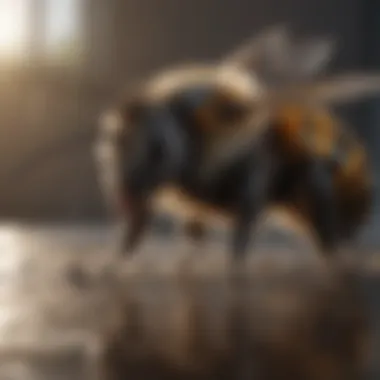
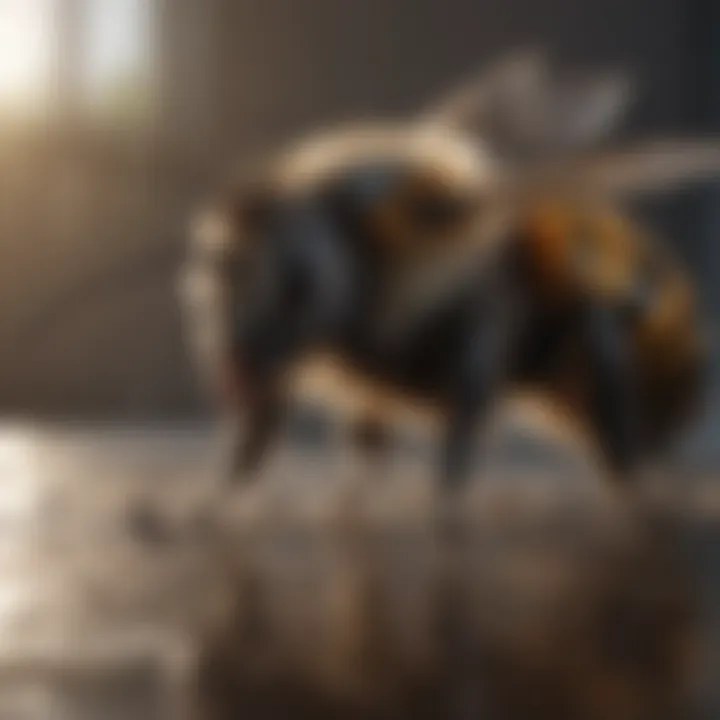
Arranging seating areas away from flowering plants also reduces the likelihood of bumblebee visits. For those who enjoy decorating their outdoor spaces, it is advisable to focus on non-floral decorations. Instead of adding new flower pots or planters, consider using ornamental grasses or non-flowering shrubs in these locations, as they do not provide food sources that bumblebees seek.
Residential Attics and Burrows
Bumblebees often seek shelter in residential attics or burrow-like spaces, as these locations offer protection from predators and harsh weather. It is vital for homeowners to conduct regular inspections in these areas to identify any potential nesting sites. Tasks might include sealing gaps or holes in walls, roofs, or eaves that could allow bumblebees to enter.
Furthermore, ensuring that attic spaces are not conducive to nesting is important. This might involve clearing the area of clutter and removing any organic materials that could attract bumblebees. In addition, if any existing nests are found, it is advisable to contact pest control professionals for safe removal, as disturbing any nest without the proper knowledge can lead to aggressive behavior from the insects.
"Identifying common settings for bumblebee encounters is the first step in effective pest management. By altering environments and addressing attractions, one can significantly reduce bumblebee presence in residential spaces."
The combination of these strategies can effectively diminish bumblebee encounters across different settings, creating a more comfortable living space for families while being mindful of the ecological role that these important pollinators play.
Factors Attracting Bumblebees
Understanding the factors that attract bumblebees is essential for homeowners who wish to minimize their presence. Bumblebees are drawn to specific elements in their environment, and by recognizing these elements, one can effectively deter them while still preserving the ecological balance. This section focuses on three primary attractants: floral sources, food waste and residues, and shelter opportunities.
Floral Sources
Bumblebees are particularly attracted to a variety of flowering plants. They depend on nectar and pollen to feed themselves and their colonies. Flowers that are rich in nectar and those that bloom throughout the growing season are especially appealing. Common examples that attract bumblebees include:
- Lavender: Its strong scent and abundant nectar make it a favorite.
- Bee Balm: As its name suggests, bee balm draws in many pollinators, including bumblebees.
- Sunflowers: Their large blooms offer a considerable amount of pollen and nectar.
When planning gardens or flower beds, homeowners should be cautious about planting species that may lure bumblebees. Instead, consider varieties that are less attractive to these pollinators, or implement barriers that limit their access.
Food Waste and Residues
Another significant factor attracting bumblebees is food waste. Improper disposal of organic waste can create an inviting environment for these insects. Sweeping crumbs, leftover food from outdoor meals, or spilled beverages can act as a beacon for bumblebees, drawing them in. Here are some actions homeowners can take to reduce these attractants:
- Proper garbage disposal: Ensure that trash cans are sealed tightly. Open garbage can serve as a food source.
- Clean up spills immediately: Remove any residues from surfaces promptly after meals.
- Maintain a tidy outdoor area: Regular cleaning of patios and outdoor dining areas can prevent bumblebees from being attracted.
By managing food waste, homeowners will significantly reduce the likelihood of bumblebee encounters near their residences.
Shelter Opportunities
Bumblebees often seek out suitable shelter to establish their nests. They are known to inhabit a variety of locations, including:
- Underground burrows: Some bumblebees create nests in pre-existing holes in the ground.
- Attics and wall cavities: Bumblebees look for secluded areas in homes for nesting. This can include attics and other hidden places.
To combat this, homeowners should closely inspect their properties and eliminate potential nesting sites. Seal access points and ensure that areas like attics are appropriately maintained.
Eliminating attractants is crucial to successfully keeping bumblebees away from your home.
By understanding and addressing these factors, homeowners can effectively create an environment that is less appealing to bumblebees while still respecting the role of these important pollinators in our ecosystems.
Preventive Measures
Preventive measures play a crucial role in managing bumblebee encounters. Understanding these strategies helps reduce the likelihood of bumblebees invading residential spaces. The key to effective prevention lies in recognizing and altering the elements that attract these pollinators while ensuring their wellbeing is still considered. Homeowners can implement specific actions to minimize interactions with bumblebees and create a more comfortable environment.
Plant Selection Strategies
Selecting the right plants is vital. When choosing plants for your garden, consider species that are less attractive to bumblebees. Opt for those that tend to produce fewer nectar sources. For example, certain shrubs and non-flowering plants can divert bumblebees away from desired areas. Additionally, using plants that bloom at different times can segment their attraction.
- Native Plants: Some native plants provide necessary food for local bees, while others may attract fewer bumblebees. A balanced mix can help.
- Color Choices: Flowers in white or blue hues tend to attract fewer bumblebees compared to vibrant colors like purple.
- Seasonal Limitations: By choosing plants with overlapping blooming periods, you can reduce bumblebee activity at specific times.
Focusing on a thoughtful selection of plants can effectively decrease bumblebee presence.
Maintaining Clean Outdoor Spaces
A clean outdoor environment significantly aids in keeping bumblebees away. Regularly tidying up the yard removes potential attractants.
- Food Residues: Ensure no food waste is left outdoors. Store leftover food in sealed containers and clean up spills immediately.
- Trash Management: Keep garbage bins tightly closed and regularly remove waste materials. This helps to eliminate any smells that might draw in bumblebees.
- Debris Clearance: Remove unnecessary clutter such as fallen fruit, decaying vegetables, and other organic matter that can serve as food sources.
By establishing a routine to maintain cleanliness, homeowners can create an environment that dissuades bumblebees from approaching.
Creating Barriers and Distractions
Incorporating physical barriers and distractions is a practical approach to managing bumblebee visitation. These methods serve to redirect bumblebees away from areas where they are not wanted.
- Fencing and Screens: Use garden fencing to create a physical boundary. Fine mesh screens can also provide a barrier while allowing airflow.
- Decoys and Traps: Utilize bumblebee decoys or traps placed strategically to lure them away from human activity areas.
- Wind Chimes and Sounds: Employing wind chimes or other noise-making devices may help dissuade bumblebees. Sound can act as a deterrent since they prefer quiet spaces.
Establishing these barriers will contribute to reducing encounters while allowing a peaceful and manageable outdoor environment.
Keeping bumblebees at bay requires a multi-faceted approach that considers both repelling and respecting these vital pollinators.
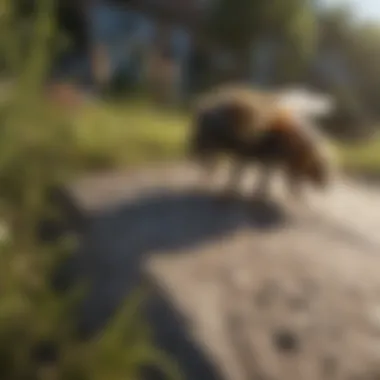
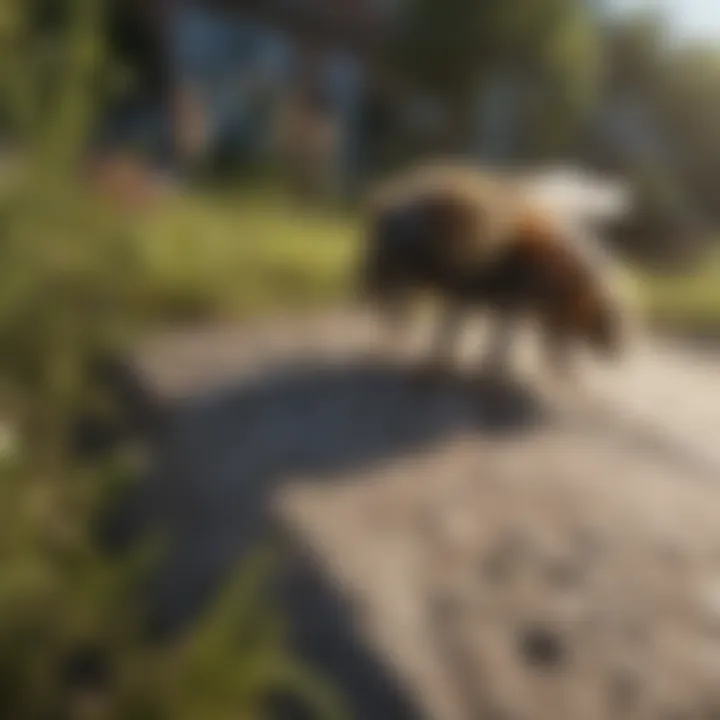
Natural Deterrents
Natural deterrents are essential in the quest to keep bumblebees away, especially for those who wish to maintain a balance between comfort at home and ecological considerations. Utilizing natural methods promotes an environment where beneficial insects can thrive without compromising personal space. Bumblebees are instinctively attracted to certain scents, foods, and floral sources. Therefore, understanding these preferences provides valuable insights into effective deterrence strategies. Below are detailed approaches to employing essential oils, herbal solutions, and homemade repellents to create an unwelcome atmosphere for bumblebees without harming the wider ecosystem.
Essential Oils
Essential oils serve as potent natural deterrents against bumblebees. Their concentrated scents can confuse or repel these insects effectively. Some of the most effective oils include peppermint, clove, and citronella. When used correctly, these oils can create barriers or diffuse unpleasant aromas that disrupt bumblebee activities.
- Peppermint Oil: Known for its strong minty aroma, peppermint can mask the scents that attract bumblebees. A few drops mixed with water in a spray bottle can be applied around doorways and windows to keep them away.
- Clove Oil: With a spicy, warm smell, clove oil not only repels bumblebees but also many other pests. Its effectiveness lies in its ability to overpower natural floral scents often found around homes.
- Citronella Oil: Traditionally used for repelling mosquitoes, citronella oil can also deter bumblebees when diffused or sprayed around external living spaces.
One note of caution: while using essential oils, it is advised to test small areas to avoid any adverse reactions, especially in outdoor spaces where pets may roam.
Herbal Solutions
Herbs can also play a significant role in deterring bumblebees from residential areas. Planting or using herbs known for their repelling properties can create defensive green barriers. Here are a few effective options:
- Basil: The strong scent of basil is known to repel various insects, including bumblebees. It can be grown in pots around patio areas or gardens.
- Mint: Similar to peppermint oil, mint plants emit a fragrance that is not appealing to bumblebees. Growing mint in gardens or containers can serve a dual purpose for cooking and pest control.
- Sage and Thyme: Both herbs possess strong scents that can deter bumblebees. Their dense foliage also provides a natural barrier when planted strategically.
Incorporating these herbs not only serves a functional purpose but also enhances the aesthetic of outdoor spaces.
Homemade Repellents
Creating homemade repellents can be a simple yet effective method to deter bumblebees. By using everyday ingredients, homeowners can produce mixtures that repel without the need for harsh chemicals. Here are some recipes:
- Vinegar Solution: Mix one part vinegar with one part water. Spray this solution around areas where bumblebees are frequent. The strong smell of vinegar will drive them away.
- Garlic Spray: Blend a few cloves of garlic with water and let it seep overnight. Strain the mix and spray it in areas of high bumblebee activity. The odor of garlic acts as a natural repellent.
- Cayenne Pepper Mixture: Dissolve cayenne pepper powder in water and spray it around entry points. Bumblebees dislike the intense heat and will avoid the area.
This approach not only fosters a bee-free zone but also utilizes items available at home, making it a cost-effective choice.
It is crucial to remember that while these natural methods are effective in keeping bumblebees at bay, they should be applied thoughtfully to ensure pollinators are not harmed unnecessarily.
By employing these natural deterrents, homeowners can effectively manage bumblebee encounters while still honoring the essential role these insects play in the environment.
Chemical Solutions
Chemical solutions are a crucial component in managing bumblebee encounters in residential areas. While many homeowners prefer natural methods, understanding chemical options can offer swift and effective results. Chemical solutions target problem areas directly, often resulting in quicker resolution than non-chemical counterparts. However, their application requires careful consideration of both effectiveness and environmental impact.
Insecticides Overview
Insecticides are commonly used to deter or eliminate bumblebees. They work by disrupting normal bodily functions or neuromuscular activities in insects. There are various types of insecticides available, including:
- Pyrethroids: These are synthetic versions of natural pyrethrins and are widely applied against many household pests.
- Neonicotinoids: They affect the nervous system of insects and are effective as a systemic insecticide, which means they can be absorbed by plants.
- Insect Growth Regulators (IGRs): These do not kill insects immediately but prevent them from maturing and reproducing.
It’s crucial to select insecticides that have proven effectiveness against bumblebees specifically, as not all insecticides will work efficiently.
Application Techniques
When applying chemical solutions, there are important techniques to ensure effective results while minimizing risks to the environment and non-target species. Key techniques include:
- Target Application: Focus on areas where bumblebees are frequently encountered, such as nests or feeding areas.
- Time of Application: Apply insecticides during late evening or early morning when bumblebees are less active.
- Direct Sprays vs. Granules: Use direct sprays for immediate coverage or granules for longer-term control, especially around nest entrances.
- Follow Manufacturer Instructions: Ensure to adhere to application rates and safety warnings provided by the manufacturer.
Safety Considerations
While chemical solutions can be effective, safety should always be at the forefront. Here are several safety considerations to take into account:
- Read Labels Carefully: Instruction manuals contain vital safety information and proper usage guidelines.
- Protective Gear: Use gloves, masks, and other protective equipment during application to avoid exposure.
- Environmental Impact: Understand the potential harm chemicals may pose to beneficial insects and the surrounding ecosystem.
- Pet and Child Safety: Keep pets and children away from treated areas until it’s deemed safe for re-entry by the manufacturer’s guidelines.
Applying insecticides may provide immediate relief, but it is essential to balance effectiveness with ecological responsibility.
Chemical solutions can serve as a quick fix for bumblebee issues. However, considering their impact on non-target organisms and the environment is essential for a balanced approach. Homeowners should not treat these solutions lightly; comprehensive knowledge and careful methodologies are needed for effective and responsible control.
Professional Pest Control Solutions
When it comes to addressing bee infestations, professional pest control offers vital resources. Homeowners may find themselves overwhelmed by both the presence of bumblebees and the potential danger they pose. In such cases, leveraging expert services can lead to effective management strategies that are safe and targeted. Pest control professionals have the training and tools necessary to assess the situation accurately, determining the best approach for both the homeowner and the bees.
When to Seek Help
Timing is key in pest management. Homeowners should consider reaching out to pest control experts when:
- Bumblebee activity increases: If bumblebees start appearing more frequently, especially during peak seasons, it's a signal that their nesting site might be nearby.
- Nesting is during the wrong time: If nests are built in inaccessible or high-traffic areas, seeking professional help can prevent potential dangers.
- Allergic reactions: For households with members who have bee allergies, quick action is necessary. Consulting professionals can ensure safety.
Knowing when to involve experts is crucial. It's about ensuring comfort in your living spaces without harming the pollinators unnecessarily.
Types of Services Available
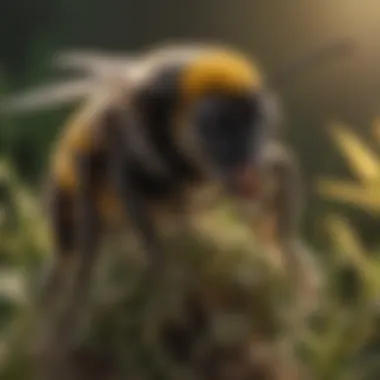
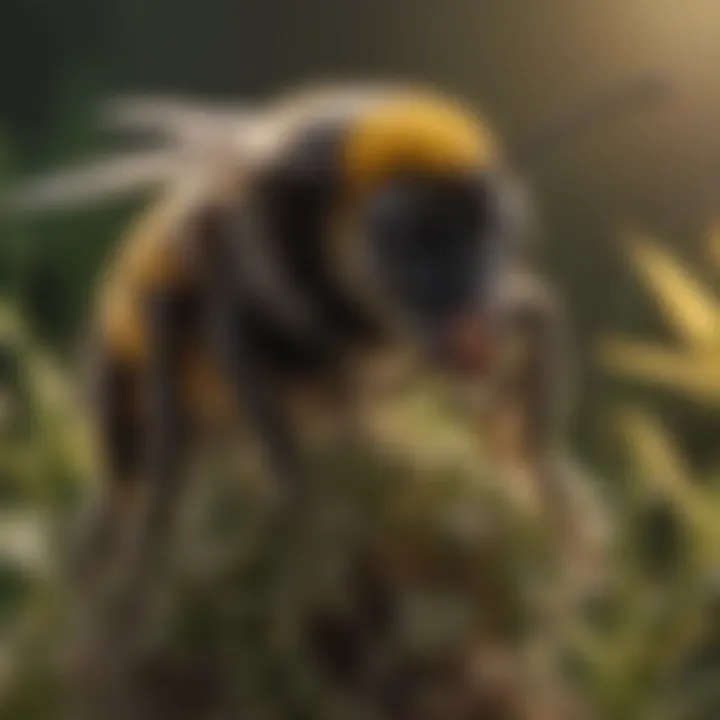
Professional pest control offers various services tailored to specific needs:
- Inspection Services: An optimal first step. Experts conduct thorough assessments to locate nests and understand the level of infestation.
- Removal Services: This involves physically removing nests and relocating them if possible. Professionals often prioritize humane solutions when handling bees.
- Preventive Treatments: Pest control providers may also offer preventative treatments to inhibit future infestations.
- Consultation and Education: Apart from physical services, many professionals will educate homeowners on best practices for maintaining bee-free environments.
These services are designed to not only address current issues but also reduce future risks.
Evaluating Pest Control Providers
Selecting the right pest control service requires careful consideration. Here are some key factors to evaluate:
- Credentials and Experience: Look for licensed and trained professionals. Experience with bumblebee control specifically is a plus.
- Methods of Control: Inquire about their pest management strategies. Are they using humane methods? Do they offer environmentally friendly options?
- Reviews and Recommendations: Check online platforms such as Reddit or social media for customer feedback.
- Cost Estimates: Gather several estimates. This will give a better understanding of market rates and help in decision-making.
Importance of diligently evaluating these aspects cannot be underestimated. The right choice will lead to a balanced approach in managing bumblebee presence while ensuring safety for both humans and pollinators.
Long-Term Management Strategies
Managing bumblebee encounters requires a proactive approach. Long-term management strategies focus on creating an environment that is less attractive to bumblebees while considering ecological balance. These strategies emphasize consistency, sustainability, and community involvement, ensuring that while homeowners minimize possible discomfort, they do not harm these essential pollinators. Fostering a harmonious relationship with the environment is part of a larger ecological picture.
Monitoring and Assessment
To effectively manage bumblebees, regular monitoring and assessment are crucial. Homeowners should pay attention to bumblebee activity patterns in their vicinity. Keeping a log of encounters can help identify peak seasons when bumblebee activity is highest. Homeowners can utilize simple tools such as notepads or apps to track sightings. Observing which areas are consistently visited by bumblebees can inform subsequent actions. Creating zones in the garden or outdoor spaces that minimize the presence of flowering plants favored by bumblebees during high seasons is a practical step. Additionally, assessing the landscape changes over time can help homeowners adapt their strategies.
Sustainable Gardening Practices
The essence of sustainable gardening lies in creating an environment that respects natural biodiversity. Homeowners should opt for non-invasive and less fragrant plants that are less appealing to bumblebees. Plants like lavender or bee balm attract these insects, so replacing them with options like ferns or ornamental grasses can lessen their presence. Ensuring that the garden area is well-maintained prevents bumblebees from nesting in areas that might be attractive to them. Regular maintenance also includes removing debris, mowing the grass, and avoiding overgrown areas.
Community Involvement in Pest Management
Community involvement plays a critical role in managing bumblebee populations effectively. Working together with neighbors can amplify the effectiveness of any strategies implemented. Awareness campaigns can be organized to educate the neighborhood about bumblebee behavior and the impact of specific plants. Possible community initiatives may include group efforts to replace high-attractant plants in commonly shared spaces or planting alternatives that are less appealing to bumblebees. Building consensus on the importance of observing and reporting bumblebee activity can also enhance monitoring. By fostering a community of informed residents, pest management can be more efficient and ecologically responsible.
Long-term strategies allow homeowners to align their pest management efforts with environmental sustainability, promoting a balance that benefits both humans and pollinators.
Legal and Ethical Considerations
The topic of legal and ethical considerations in pest management is crucial for homeowners dealing with bumblebee encounters. Engaging in pest control practices without regard for the law or the environment can lead to serious consequences. It’s necessary to acknowledge that bumblebees are essential pollinators, and many species are protected under local and national laws. Understanding these legal frameworks not only informs the homeowner about what they can or cannot do but also promotes a sense of responsibility towards these insects.
Ethical considerations also play a significant role in how we manage our living spaces in relation to bumblebees. Many people may automatically resort to lethal methods for deterring these insects, but there are alternatives that not only protect the homeowner’s comfort but also safeguard the well-being of bumblebees. By considering these factors, individuals can implement effective pest management strategies that are humane and environmentally responsible.
Protection of Pollinators
Bumblebees, as vital pollinators, contribute significantly to the ecosystem. Their role in pollinating crops and wild plants helps sustain biodiversity and food production. Protecting them is essential because their decline can lead to negative impacts on agricultural yield and ecological balance. Many areas have enacted laws to protect threatened bumblebee species, prohibiting their harm or the destruction of their habitats.
Homeowners can participate in protection efforts by creating a bee-friendly environment when possible. This may include planting native flowers and providing suitable habitat spaces that do not interfere with their natural behaviors. Furthermore, awareness campaigns often seek to educate communities about the benefits of having bumblebees, and participating in these can strengthen community ties and promote local ecological awareness.
Local Regulations on Pest Control
Regulations on pest control are diverse, depending on the region. Many areas have specific guidelines that govern the use of chemicals and practices related to pest management. It is crucial for homeowners to familiarize themselves with these regulations to avoid potential legal issues. Ignoring local laws can result in fines or other penalties, which can be financially burdensome
In the context of bumblebees, certain measures may be restricted or categorized as illegal. For example, using certain pesticides that are harmful to pollinators might be banned. Homeowners should consult local legislation or pest control authorities to ensure compliance. Checking resources like local government websites or environmental organizations can provide clarity on what is permissible in their area.
Ethical Pest Management Practices
Ethical pest management practices prioritize humane methods over lethal options, promoting a balance between property safety and ecological responsibility. Homeowners should seek out options that do not harm bumblebees while effectively managing their presence. This may involve using barriers to deter bees from certain areas rather than resorting to extermination.
Additionally, community awareness can lead to adoption of better practices. Homeowners can encourage discussions on sustainable pest management within their neighborhoods. Techniques such as education on proper waste disposal to avoid attracting bumblebees or using natural deterrents, like essential oils, are effective and ethical. Overall, ethical pest management practices foster both community health and environmental stewardship.
Final Note: Understanding legal and ethical considerations promotes a respectful approach to living harmoniously with bumblebees, emphasizing the importance of these pollinators in our ecosystem.
Epilogue
The conclusion serves as a pivotal moment in our exploration of ways to keep bumblebees away from residential spaces while maintaining ecological integrity. It encapsulates the strategies discussed and emphasizes the delicate balance that needs to be struck between effective pest management and the protection of our vital pollinators.
Review of Strategies
Throughout the article, various methods have been outlined, ranging from natural deterrents such as essential oils and home-made repellents to chemical solutions when necessary. Preventive measures, including selective plant choices and maintaining cleanliness in outdoor spaces, have been emphasized. Each approach is necessary, but it is critical that homeowners recognize when to utilize these methods.
In summary, the key strategies to deter bumblebees include:
- Implementing natural deterrents.
- Utilizing insecticides judiciously and safely.
- Seeking professional help when infestations exceed personal control.
The combination of these measures allows for adaptability in dealing with bumblebees, ensuring that discomfort due to their presence does not lead to harm against these essential creatures, as they play a significant role in pollination.
Importance of Balance
Finding a balance is central to achieving a sustainable environment around our homes. It involves understanding that while it may be necessary to keep bumblebees away, it should not come at the expense of their population or the greater ecological framework. Homeowners must take a measured approach, always considering the long-term benefits of maintaining a healthy balance in nature.
Incorporating sustainable gardening practices and engaging in community involvement for pest management can offer better results. This not only helps in controlling bumblebee populations but also supports biodiversity.
"By viewing pest management as a holistic practice, we reinforce the ecosystems that sustain us while protecting our living spaces."



